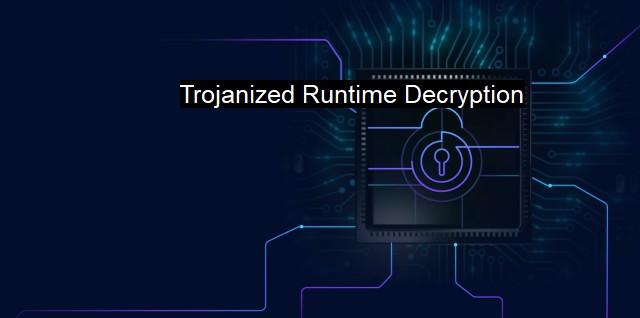What is Trojanized Runtime Decryption?
Unlocking the Security Flaw: Trojanized Runtime Decryption in Today's Evolving Cybersecurity Landscape
Trojanized Runtime Decryption is a cyber security concept and technique that involves the embedding of malicious code inside a seemingly harmless program or an application. This technique is commonly used by hackers and cyber-criminals in order to penetrate the defense systems of both an entity or individual's software and hardware resources. These trojanized encrypted payloads often evade traditional security countermeasures like antivirus software and intrusion detection systems, enabled by off-the-shelf packers and crypting services. They remain hidden until they reach the targeted system, where they decrypt or decompress themselves at runtime to launch a cyber attack.The concept of trojanizing applications is derived from the ancient Greek myth of the "Trojan Horse". Just as the hollow wooden horse was filled with Greek soldiers and presented as a gift to get inside the fortified city of Troy, a Trojan horse program seems legitimate and innocent at first glance, but carries a harmful payload.
A common execution process of Trojanized Runtime Decryption involves the use of a benign carrier (commonly known as the "wrapper") which holds the hidden malicious software (malware). The wrapper decrypts or unzips the contents when it is executed at runtime, initiating the malicious code hidden within.
Antivirus software attempts to detect the malicious behavior exhibited by executable files when they run. if an executable is packed or encrypted, the actual malicious code isn't visible until after it's run, making it challenging for traditional antivirus software. Thus, Trojanized Runtime Decryption becomes more potent, surreptitious, and consequently lethal against cyber security infrastructures owing to its decryption characteristic at runtime.
With the growing use and dependence on applications in the interconnected world, cyber-criminals are refining the Trojan technique with Runtime Decryption to bypass and beat regular security protocols. Encrypted or compressed using sophisticated algorithms and keys, each payload is different, even if it derives from the same Trojan family, making detection even more complex.
The use of multiple layers of packers or even custom packers further increases security challenges. In such methods, where layered packing or multi-level packing is employed, each unpacked layer brings forth a new layer needing to be decrypted until you reach the core of the malware. Thus, it’s a situation quite like peeling an onion layer by layer until the actual layer containing malware is found, complicating anti-malware scanning mechanisms.
Cybersecurity solutions to this problem involve implementing active runtime protection mechanisms and behavioral analysis. Runtime protection can monitor applications for malicious behaviors and halt the operation before the malicious payload has a chance to run. Behavioral-based defense systems are designed to monitor network behaviors to recognize patterns consistent with malware. They identify abnormal patterns such as changes in regular data flow or unauthorized access to data.
Cloud-based security services which receive continuous updates about latest threats can also handle such threats better than traditional security systems. Regular software and system updates, employing best practices related to clicking and downloading behaviors as well as administrative control will also add to the safety.
Trojanized Runtime Decryption presents a sophisticated method for delivering malware and increases the difficulty level in safeguarding systems. Therefore, a multi-layered defense strategy is crucial in defending against such threats. This evolving threat landscape emphasizes the need for continuous innovation and collaboration to develop robust security solutions that can counteract such advanced techniques.

Trojanized Runtime Decryption FAQs
What is Trojanized Runtime Decryption?
Trojanized Runtime Decryption is a type of malware attack that involves the injection of malicious code into the system's runtime environment. The goal of this attack is to evade detection by security software and to execute the malware without being detected.How does Trojanized Runtime Decryption work?
Trojanized Runtime Decryption works by using encryption to conceal the malicious code, which is then decrypted at runtime. This allows the malware to bypass traditional antivirus and security measures, which typically scan for or block known malware signatures. Once the code is decrypted, it can execute its malicious functions undetected, such as stealing data, taking control of the system, or spreading to other machines on the network.How can I protect myself from Trojanized Runtime Decryption attacks?
To protect yourself from Trojanized Runtime Decryption, you should use advanced security measures such as behavior-based detection and sandboxing. This can help identify suspicious behavior in the system and isolate potentially malicious code. Additionally, you should keep your antivirus and security software up to date, and be wary of downloading or opening any suspicious files or attachments, particularly from unknown sources.What are the consequences of a Trojanized Runtime Decryption attack?
The consequences of a Trojanized Runtime Decryption attack can be severe, including data theft, system compromise, and potential damage to your reputation. The malware can also spread to other machines on the network, leading to a larger-scale security breach. In some cases, the attackers may even demand ransom to release control of the system. It is important to take immediate action to mitigate the impact of such an attack and prevent further damage.| | A | | | B | | | C | | | D | | | E | | | F | | | G | | | H | | | I | | | J | | | K | | | L | | | M | |
| | N | | | O | | | P | | | Q | | | R | | | S | | | T | | | U | | | V | | | W | | | X | | | Y | | | Z | |
| | 1 | | | 2 | | | 3 | | | 4 | | | 7 | | | 8 | | |||||||